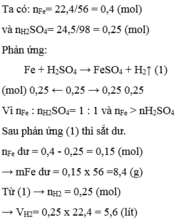Hãy nhập câu hỏi của bạn vào đây, nếu là tài khoản VIP, bạn sẽ được ưu tiên trả lời.

nFe = 22.4/56 = 0.4 (mol)
nH2SO4 = 24.5/98 = 0.25 (mol)
Fe + H2SO4 => FeSO4 + H2
0.25.....0.25.....................0.25
mFe(dư) = ( 0.4 - 0.25 ) * 56 = 8.4 (g)
VH2 = 0.25 * 22.4 = 5.6 (l)
nFe=\(\dfrac{22,4}{56}\)= 0,4 ( mol)
nH2SO4=\(\dfrac{24,5}{98}\)=0,25 ( mol )
Fe + H2SO4 → FeSO4 + H2
Trước phản ứng: 0,4 0,25 ( mol )
Phản ứng: 0,25 0,25 0,25 ( mol )
Sau phản ứng: 0,15 0,25 0,25 ( mol )
a) m= n.M= 0,15.56=8,4 (g)
vậy Fe còn dư và dư 8,4 gam
b) VH2= n.22,4= 0,25.22,4=5,6 (l)

Bài 1.
\(n_{Fe}=\dfrac{5,6}{56}=0,1mol\)
\(Fe+H_2SO_4\rightarrow FeSO_4+H_2\)
0,1 0,1 0,1 0,1
\(V_{H_2}=0,1\cdot22,4=2,24l\)
\(n_{CuO}=\dfrac{12}{80}=0,15mol\)
\(CuO+H_2\rightarrow Cu+H_2O\)
0,15 0,1
\(\Rightarrow CuO\) dư và dư \(\left(0,15-0,1\right)\cdot80=4g\)
Bài 2.
\(n_P=\dfrac{3,1}{31}=0,1mol\)
\(4P+5O_2\underrightarrow{t^o}2P_2O_5\)
0,1 0,125
\(V_{O_2}=0,125\cdot22,4=2,8l\)
\(n_{Zn}=\dfrac{19,5}{65}=0,3mol\)
\(2Zn+O_2\underrightarrow{t^o}2ZnO\)
0,3 0,125 0
0,25 0,125 0,25
0,05 0 0,25
\(\Rightarrow ZnO\) dư và dư \(0,05\cdot81=4,05g\)
Bài 1.
a, \(n_{Fe}=\dfrac{5,6}{56}=0,1\left(mol\right)\)
PTHH: Fe + H2SO4 ---> FeSO4 + H2
Mol: 0,1 0,1
b, \(V_{H_2}=0,1.22,4=2,24\left(l\right)\)
c, \(n_{CuO}=\dfrac{12}{80}=0,15\left(mol\right)\)
Ta có: \(\dfrac{0,15}{1}>\dfrac{0,1}{1}\) ⇒ CuO dư, H2 hết
PTHH: CuO + H2 ---to----> Cu + H2O
Mol: 0,1 0,1
\(m_{CuOdư}=\left(0,15-0,1\right).80=4\left(g\right)\)

a, \(Mg+2HCl\rightarrow MgCl_2+H_2\)
Ta có: \(n_{Mg}=\dfrac{7,2}{24}=0,3\left(mol\right)\)
Theo PT: \(n_{H_2}=n_{Mg}=0,3\left(mol\right)\Rightarrow V_{H_2}=0,3.22,4=6,72\left(l\right)\)
b, \(n_{Fe_2O_3}=\dfrac{48}{160}=0,3\left(mol\right)\)
PT: \(Fe_2O_3+3H_2\underrightarrow{t^o}2Fe+3H_2O\)
Xét tỉ lệ: \(\dfrac{0,3}{1}>\dfrac{0,3}{3}\), ta được Fe2O3 dư.
Theo PT: \(n_{Fe_2O_3\left(pư\right)}=\dfrac{1}{3}n_{H_2}=0,1\left(mol\right)\Rightarrow n_{Fe_2O_3\left(dư\right)}=0,3-0,1=0,2\left(mol\right)\)
\(\Rightarrow m_{Fe_2O_3}=0,2.160=32\left(g\right)\)

a, \(n_{Fe}=\dfrac{11,2}{56}=0,2\left(mol\right)\)
\(n_{H_2SO_4}=\dfrac{29,4}{98}=0,3\left(mol\right)\)
PT: \(Fe+H_2SO_4\rightarrow FeSO_4+H_2\)
Xét tỉ lệ: \(\dfrac{0,2}{1}< \dfrac{0,3}{1}\), ta được H2SO4 dư.
Theo PT: \(n_{H_2SO_4\left(pư\right)}=n_{Fe}=0,2\left(mol\right)\Rightarrow n_{H_2SO_4\left(dư\right)}=0,3-0,2=0,1\left(mol\right)\)
\(\Rightarrow m_{Fe}=0,1.98=9,8\left(g\right)\)
b, \(n_{H_2}=n_{Fe}=0,2\left(mol\right)\Rightarrow n_{H_2}=0,2.22,4=4,48\left(l\right)\)
c, \(n_{CuO}=\dfrac{24}{80}=0,3\left(mol\right)\)
PT: \(CuO+H_2\underrightarrow{t^o}Cu+H_2O\)
Xét tỉ lệ: \(\dfrac{0,3}{1}>\dfrac{0,2}{1}\), ta được CuO dư.
Theo PT: \(n_{Cu}=n_{H_2}=0,2\left(mol\right)\Rightarrow m_{Cu}=0,2.64=12,8\left(g\right)\)

4) x,y lần lượt là số mol của M và M2O3
=> nOxi=3y=nCO2=0,3 => y=0,1
Đề cho x=y=0,1 =>0,1M+0,1(2M+48)=21,6 =>M=56 => Fe và Fe2O3
=> m=0,1.56 + 0,1.2.56=16,8
2)X + 2HCl === XCl2 + H2
n_h2 = 0,4 => X = 9,6/0,4 = 24 (Mg)
=>V_HCl = 0,4.2/1 = 0,8 l

\(n_{Fe}=\dfrac{22,4}{56}=0,4\left(mol\right);n_{H_2SO_4}=\dfrac{24,5}{98}=0,25\left(mol\right)\\ PTHH:Fe+H_2SO_4\rightarrow FeSO_4+H_2\\ Vì:\dfrac{0,4}{1}>\dfrac{0,25}{1}\Rightarrow Fe.dư\\ n_{H_2}=n_{Fe\left(p.ứ\right)}=n_{H_2SO_4}=0,25\left(mol\right)\\ a,V_{H_2\left(đktc\right)}=0,25.22,4=5,6\left(l\right)\\ b,n_{Fe\left(dư\right)}=0,4-0,25=0,15\left(g\right)\\ m_{Fe\left(dư\right)}=0,14.56=8,4\left(g\right)\)

a. PTHH :Fe + H2SO4 -> FeSO4 +H2
nFe = 22,4 : 56 = 0,4 (mol)
nH2SO4 = 24,5 : 98 = 0,25 (mol)
Ta có nFe > nH2SO4 (0,4>0,25) nên Fe dư
nFe dư = 0,4-0,25 = 0,15 (mol)
Vậy mFe dư = 0,15 . 56 = 8,4 (gam)
b, Theo PTHH ta có nH2 = nH2SO4 =0,25 (mol)
=> VH2 thu được (đktc) =0,25 . 22,4 =5,6(lit)
Ta có: \(n_{Fe}=\dfrac{22,4}{56}=0,4\left(mol\right)\\ n_{H_2SO_4\left(loãng\right)}=\dfrac{24,5}{98}=0,25\left(mol\right)\)
PTHH: Fe + H2SO4 (loãng) -> FeSO4 + H2\(\uparrow\)
Theo PTHH và đề bài, ta có:
\(\dfrac{n_{Fe\left(đềbài\right)}}{n_{Fe\left(PTHH\right)}}=\dfrac{0,4}{1}>\dfrac{n_{H_2SO_4\left(loãng,đềbài\right)}}{n_{H_2SO_4\left(loãng,PTHH\right)}}=\dfrac{0,25}{1}\)
=> H2SO4 loãng hết, Fe dư nên tính theo \(n_{H_2SO_4\left(loãng\right)}\)
Theo PTHH và đề bài, ta có:
\(n_{H_2}=n_{Fe\left(phảnứng\right)}=n_{H_2SO_4\left(loãng\right)}=0,25\left(mol\right)\\ =>n_{Fe\left(dư\right)}=0,4-0,25=0,15\left(mol\right)\)
a) Khối lượng Fe dư:
\(m_{Fe\left(dư\right)}=0,15.56=8,4\left(g\right)\)
b) Thể tích khí H2 thu được (ở đktc):
\(V_{H_2\left(đktc\right)}=0,25.22,4=5,6\left(l\right)\)

Linh Thực ra đặt hóa trị thì cân bằng phương trình và tính theo đó cũng không khó mà?
b3
pt:2Fe+3H2SO4→→Fe2SO4+H2
a)nFe=m\M=22,4\56 =0,4(mol)
nFe2(SO4)3=m\M=24,5\340=0,07(mol)
Theo pt ta có tỉ lệ :
0,4\2>0,07\1
=>nFe dư , nFe2(SO4)3
nên ta tính theo nFe2(SO4)3
=> nFe dư = nFe đề bài - nFe phản ứng
= 2-0,2=1,8(mol)
=>mFe = n x M = 1,8 x 56 = 100,8(g)
b) Theo pt: nH2 = nFe = 1,8 (mol)
VH2 = n x 22,4 = 1,8 x 22,4 = 40,32 (l)
b4
Dùng một que đóm đang cháy cho vào mỗi lọ:
– Lọ không làm thay đổi ngọn lửa: lọ chứa không khí.
– Lọ làm que đóm cháy với ngọn lửa màu xanh mờ và có tiếng nổ lách tách nhẹ là lọ chứa hi đro (hoặc lọ còn lại chứa hiđro)
b5
2M+2HCl->2MCl+H2
2M\0,24=2\0,02
M=12
ta xét :x=1=>12 loại
..............x=2=>24 Mg
.................x=3=>36 loại
vậy kl lag Mg